Here Comes Everybody
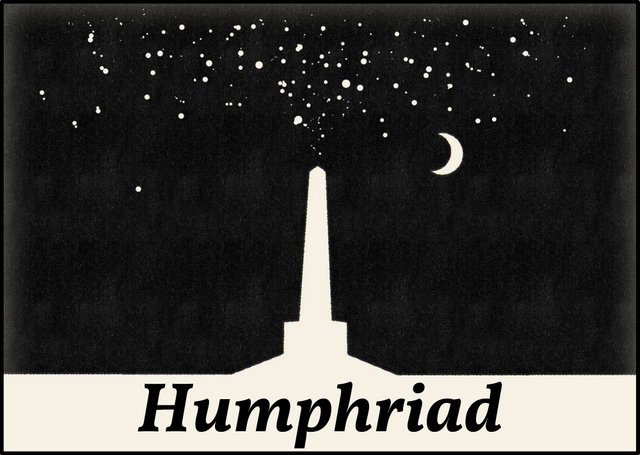
As I have mentioned several times already in this series on James Joyce’s Finnegans Wake, the opening chapter of the novel was written as an afterthought. Joyce actually began drafting the book with what is now the second chapter (I.2, or Book I, Chapter 2). In the sixth article of this series—this, by the way, is the seventy-eighth article—I described the curious manner in which Joyce groped his way towards his final masterpiece. A brief review of his progress would not be out of place here.
To Start with in the Beginning
On 11 March 1923 James Joyce wrote a short letter to his benefactress Harriet Shaw Weaver. After discussing Ulysses and the medical treatment he was receiving for his failing eyesight, he added, almost by way of a postscript:
Yesterday I wrote two pages—the first I have written since the final Yes of Ulysses. Having found a pen, with some difficulty I copied them out in a large handwriting on a double sheet of foolscap so that I could read them. Il lupo perde il pelo ma non il vizio, the Italians say. The wolf may lose his skin but not his vice or the leopard cannot change his spots. (Letters I 11 March 1923)
After six months of fishing for a theme and exhaustive notetaking, Joyce had finally begun to write Finnegans Wake.
Well, sort of.
The final phase of the genesis of Finnegans Wake is also the least understood. It lasted about six months, during which Joyce drafted several vignettes—character sketches—each one no more than a page or two in length:
- Roderick O’Conor
- St Kevin’s Orisons
- Tristan and Isolde
- St Dympna
- Mamalujo (The Four Waves of Erin)
- St Patrick and the Druid
- Here Comes Everybody
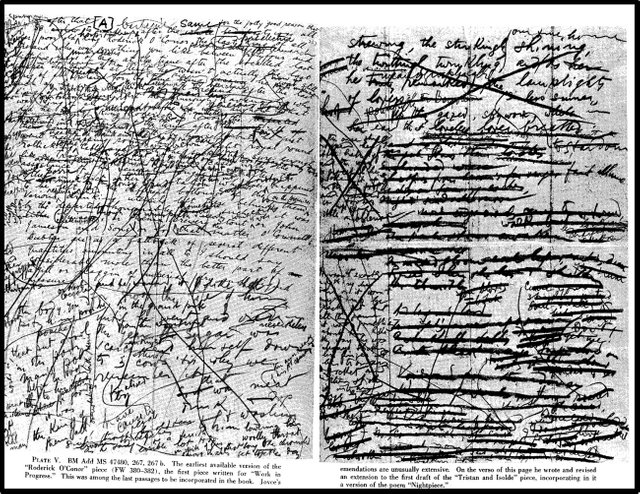
These vignettes are akin to the charcoal studies an artist might make in his sketchbook before putting paint to canvas. With one exception, they were actually incorporated into the final text of Finnegans Wake—usually at a very late date in the composition of the book and after significant revision. It is possible that Joyce drafted other vignettes that are no longer extant or that have found their way into private collections. St Dympna, the one sketch that was not deemed worthy of inclusion in the final text, only turned up in 2004 and its existence was a complete surprise to the world of Wakean scholarship (Henkes 3).
In the months of March-August 1923 Joyce drafted and redrafted these sketches, continually elaborating and expanding them. It was only in August 1923, with the drafting of the final vignette, Here Comes Everybody, that he truly began to write Finnegans Wake. That is to say, he sat down and wrote what he subsequently thought of as the opening lines of his next book.
Finnegans Wake began life as an elaboration, or expansion, of the short sketch called Here Comes Everybody:
In November 1923 Joyce expanded the “Here Comes Everybody” sketch into a full-scale, albeit episodic, narrative of a carnivalesque HCE and his possible sexual malfeasance ... and the gradual, farcical destruction of his reputation by malicious slander ... In “Here Comes Everybody” HCE acquires his agnomen and in the extension he loses it. This section forms ... the “kernel draft” of chapters 2-4 in Book I of Finnegans Wake. (Crispi & Slote 13)
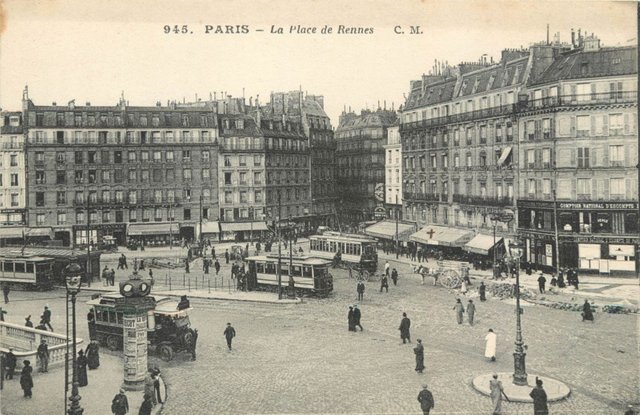
Here Comes Everybody
The earliest draft of “Here Comes Everybody” can be read on the archived version of Jorn Barger’s Robotwisdom website. With the help of David Hayman’s A First-Draft Version of Finnegans Wake (Hayman 62-63) and Danis Rose & John O'Hanlon's James Joyce Digital Archive, I have slightly emended Barger’s version:
Concerning the origin of his agnomen the most authentic version has it that like Cincinnatus he was one day at his plough when royalty was announced on the highroad. Forgetful of all but his fealty he hastened out on to the road, holding aloft a long perch atop of which a flowerpot was affixed. On his majesty, who was rather longsighted from early youth, inquiring whether he had been engaged in lobstertrapping Humphrey bluntly answered: ‘No, my liege, I was only a cotching of them bluggy earwigs’. The King upon this smiled heartily and, giving way to that none too genial humour which he had inherited from his great aunt Sophy, turned towards two of his retinue, the lord of Offaly and the mayor of Waterford (the Syndic of Drogheda according to a later version) remarking ‘How our brother of Burgundy would fume did he know that he have this trusty vassal who is a turnpiker who is also an earwicker’. True facts as this legend may be it is certain that from that date all documents initialled by Humphrey bear the sigla H.C.E. and whether he was always Coxon for his cronies and good duke Humphrey for the ragged tiny folk of Lucalizod it was certainly a pleasant turn of the populace which gave him as sense of these initials the nickname ‘Here Comes Everything’. Imposing enough indeed he looked and worthy of that title as he sat on gala nights in the royal booth with wardrobepanelled coat thrown back from a shirt wellnamed a swallowall far outstarching the laundered ladies and marbletopped highboys of the pit. A baser meaning has been read into these letters, the literal sense of which decency can but touch. It has been suggested that he suffered from a vile disease. To such a suggestion the only selfrespecting answer is to affirm that there are certain statements which ought not to be, and one would like to be able to add, ought not to be allowed to be made. Nor have his detractors mended their case by insinuating that he was at one time under the imputation of annoying soldiers in the park. To anyone who knew and loved H- C- E- the suggestion is preposterous. Slander, let it do its worst, has never been able to convict that good and great man of any greater misdemeanour than that of an incautious exposure and partial at that in the presence of certain nursemaids whose testimony is, if not dubious, at any rate slightly divergent.
Of the drafts collated by Rose & O’Hanlon, the earliest is catalogued as:
1st draft, August-September 1923, I.2§1 draft level 0
MS British Library 47472 97
Another and fuller catalogue reads:
First draft (ink) - written on “Restaurant des Trianons” notepaper; probably August-September 1923 (see Letters III, 23 August 1923).
MS: BL 47472, fols. 97r, 97v
JJA 45 (Book I Chapters 2 and 3): 2-3
Notebooks used: SA (VI.A) (earliest), N1 (VI.B.10), N3 (VI.B.3), N4 (VI.B.25) (workbook missing in part), N5 (VI.B.2)
This draft is already about twice as long as Barger and Hayman’s first draft, but that is because Rose & O’Hanlon have collated in this draft all the revisions Joyce made to the original draft before making a fair copy (probably in September 1923). If you revert these revisions, you will recover the true original draft. There are, however, a few discrepancies between the three versions (Barger, Hayman, Rose & O’Hanlon). For example, Rose & O’Hanlon give origin as the third word in the first draft, whereas Barger and Hayman suggest that Joyce first wrote genesis and never altered it.
In a footnote, Hayman confirms that the first draft was written on Restaurant de Trianons stationery (Hayman 62-63, fn 12). Les Trianons, 5 La Place de Rennes (now La Place du 18-Juin-1940, at the junction of the Boulevard du Montparnasse and the Rue de Rennes), was Joyce’s favourite restaurant in the 1920s. It no longer exists. In the letter of 23 August 1923, Joyce tells Harriet Shaw Weaver that he has begun drafting other parts in spite of the heat, noise, confusion and suffocation. JJA 45 refers to Volume 45 of the James Joyce Archive.
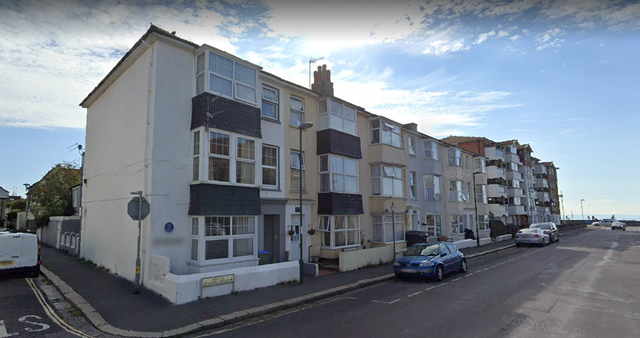
Bognor
Between 29 June and 2 August 1923, Joyce stayed at Alexandra Guest House on Clarence Road in Bognor, a popular watering hole on the south coast of England (Norburn 110). It was in a local guidebook that he first came across the name Earwicker:
While looking for sources of the earliest sections of the Wake, I came across the Ward, Lock & Co. Illustrated Guide Book for Bognor and Region, entitled A Pictorial and Descriptive Guide to Bognor, etc., the Fourth edition for 1922-1923. Under Sidlesham, we find the following paragraph:
Sidlesham Church is an Early English structure worthy of notice, and an examination of the surrounding tombstones should not be omitted if any interest is felt in deciphering curious names, striking examples being Earwicker, Glue, Gravy, Boniface, Anker, and Northeast. (Timmerman 45)
Peter Timmerman struck gold with this discovery, which turned up several other details relevant not only to the Humphriad but to later sections of Finnegans Wake:
Joyce very likely picked up a copy of this guide, either purchasing it for his trip, or perhaps finding it by chance in Alexandra House, the Bognor hotel at which he was staying. He would have been struck by the curious coincidence of the names ‘Wicker’ and ‘Earwicker’ and would have built up the scene with this assistance.
If Joyce used the guide, he kept it—or notes made from it—for some time. In the first draft (B.M. Add. MS 47472, 97a) we find only ‘the Glues & Gravys & Earwickers of Sidlesham’, ‘the Northeasts, the Ankers’ being added to the first typescript (B.M. Add. MS 47472, 102a) as mentioned in Joyce’s letter Harriet Weaver of 9 October 1923 (Letters, I, 204). This emboldens us to look at some of the other material in the guide that may be of more marginal relevance. (Timmerman 46)
It is tempting to assume that Humphrey’s roadside encounter with the king was suggested by Bognor’s own agnomen, Regis, but—alas!—Bognor only came to be known as Bognor Regis in 1929, when George V convalesced there after undergoing lung surgery.
Timmerman concludes his article with the following sentiments:
The transportation of this region to Dublin would have come naturally to Joyce’s mind, and may help to explain the transitions between Dublin and the south of England that occur in the early chapters of FW ...
To posit such a pervasive influence for one guide book is on the face of it extravagant; yet is just the sort of thing Joyce was likely to fasten on, especially if one visualises him both deciding to begin his new work in earnest and also relaxing on vacation. What better guide to the future than the guide closest at hand? (Timmerman 48)
It’s possible that Joyce began Here Comes Everybody when he was still in Bognor, though the “Restaurant des Trianons” stationery suggests otherwise. Nora Barnacle’s sister Kathleen accompanied them to Bognor for the holiday, and Richard Ellmann records the following interesting exchange:
In Bognor Nora remarked resignedly to Kathleen, ‘He’s on another book again.’ Joyce worked at Finnegans Wake with passion. (Ellmann 554)
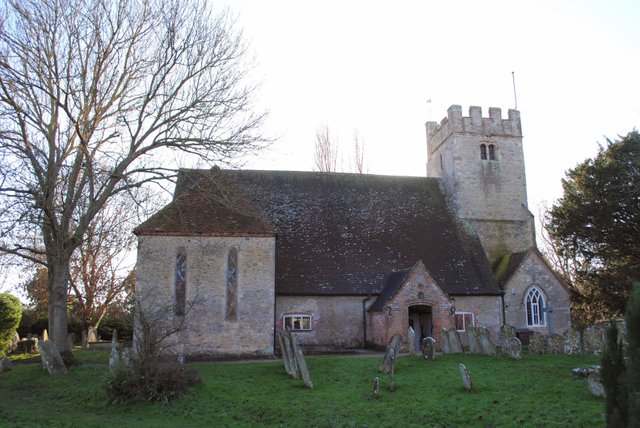
The Humphriad
Here Comes Everybody was the little acorn from which Finnegans Wake grew, but it was also, in a sense, the first draft of I.2-4, the first three chapters of the book to be written. Because this triad of chapters recounts in a mock-heroic style the self-contained story of HCE’s rise and fall, it is sometimes referred to as the Humphriad.
The central idea of HCE as a modern Everyman—a latter-day Adam whose fall from grace is precipitated by a sin committed in a garden—is present from the beginning:
Earwicker’s original sin, never precisely described, occurred in the Phoenix Park and involved exhibitionism, or voyeurism, with two nursemaids as accomplices, and three soldiers (imported perhaps from the Circe episode of Ulysses) as witnesses, quite possibly themselves involved in the offense through promiscuity with the girls or homosexuality with each other. (Ellmann 555)
The two nursemaids and three soldiers may in fact have been lifted from Joseph Bédier’s retelling of the romance of Tristan and Isolde, Le Roman de Tristan et Iseut, which Joyce is known to have read while he was living in Trieste. The library of books that he left behind when he moved to Paris in June 1920 includes both the original French edition as well as Florence Simmonds’ English translation of 1910:
The varlets kept the fool [Tristan, who has lost his wits] for their amusement on the steps of the hall, like a dog in a kennel. He bore their jests and blows patiently, for sometimes, restored to his own shape and comeliness, he passed from his lair to the Queen’s chamber. But when some days had passed, two of the serving-maids suspected the fraud. They warned Andret, who placed three spies well armed at the door of the women’s chambers. When Tristram would have entered they cried : “Back, fool, return to thy bundle of straw.” “What! fair gentlemen,” said the fool, “must I not go this evening to embrace the Queen? Know you not that she loves me?” Tristram brandished his club. They were afraid, and let him enter. (Simmonds 202-203, Bédier 264-265)
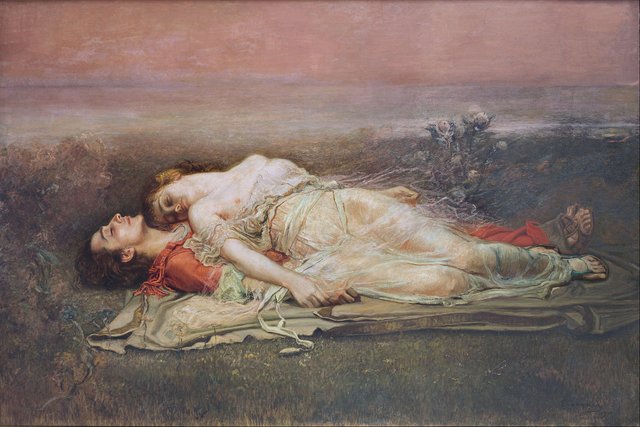
It appears that when Joyce expanded Here Comes Everybody into the Humphriad, he intended the latter to take up a single chapter in his nascent novel:
Chapters 2-4, the first part of the Wake to be drafted, make up a self-contained narrative unit that presents the nature and history of the book’s hero, HCE. It served as the beginning of the Wake until 1926, when Joyce drafted what would become chapter 1. Joyce’s composition of the unit began in August 1923 with the drafting and revising of the “vignette” usually called “Here Comes Everybody,” which was to take its place as the first section of chapter 2 [RFW 024.01–027.32]. Then in the fall and winter of 1923-24 he drafted the rest of chapter 2 and chapters 3 and 4, though the separation into the final chapter units only came later, to meet the requirements of serial publication. (Crispi & Slote 66)
During the composition of Work in Progress (as Finnegans Wake was originally called) Joyce was put to many shifts in order to remain relevant to his reading public. In an earlier article, I described what was perhaps the most important of these: the regular publication of early fragments of the novel. Here Comes Everybody was the second of these, appearing in the anthology Contact Collection of Contemporary Writers, which was edited by Robert McAlmon and published in Paris in 1925.
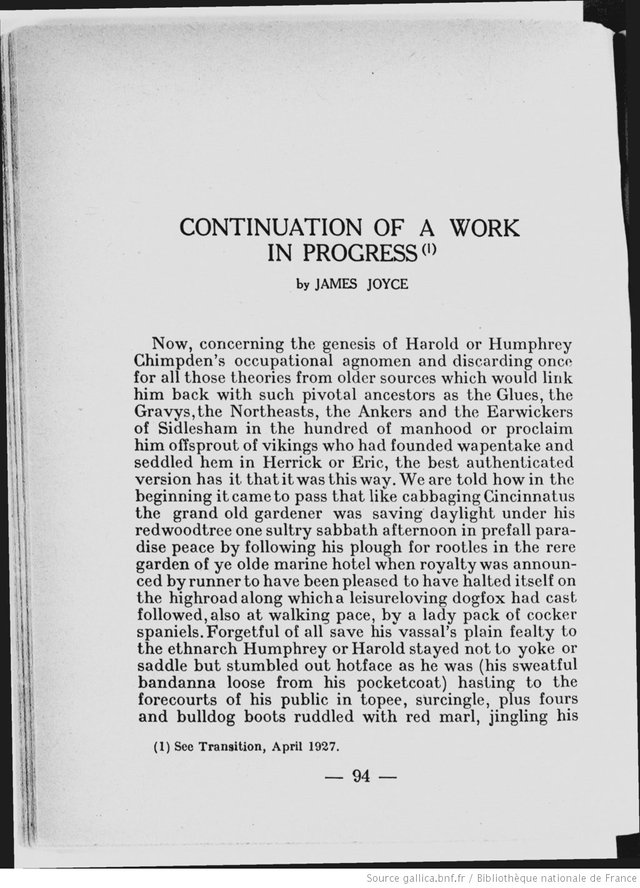
In September 1926, after several more fragments had been published, Joyce wrote to Harriet Shaw Weaver about his failure to get a fragment into the esteemed American magazine The Dial:
I am sorry the Dial has rejected the pieces as I wanted them to appear slowly and regularly in a prominent place. (Letters 24 September 1926)
Just as Joyce was beginning to sense that many of those who had championed the author of Ulysses were losing interest in the author of Work in Progress, a new coterie of admirers materialized. Among these were Eugene and Maria Jolas, Myron and Helen Nutting, and Elliot Paul. In January 1927, following a private reading by Joyce of the opening lines of Work in Progress, these new friends agreed to serialize Joyce’s novel from the beginning.
Eugene Jolas was already in the process of founding a literary magazine, which would be called transition. This magazine became the principal vehicle for the serialization of Work in Progress.
Twenty-seven numbers of transition appeared between April 1927 and May 1938. The first eight installments serialized the eight chapters of Book I, with I.2-4 appearing in transition 2-4 (May, June, July 1927). It was to facilitate this publication that Joyce finally split the Humphriad into three chapters.
Joyce did not simply divide one long tale into three sections for separate publication. He revised each section prior to publication:
In the spring of 1927 in the fair copy of the first typescript all the sections had been drafted and their sequence established. It only remained for Joyce to determine their final segmentation into episodes for publication in transition and to make changes that would organize their proper symmetries and echoes. (Crispi & Slote 87)
He even made changes while proofreading the galleys prior to the final typesetting and printing (Crispi & Slote 80, 82, 84, 85). Needless to remark, the three chapters underwent further revisions over the course of the following eleven or twelve years, before the publication of Finnegans Wake in May 1939.
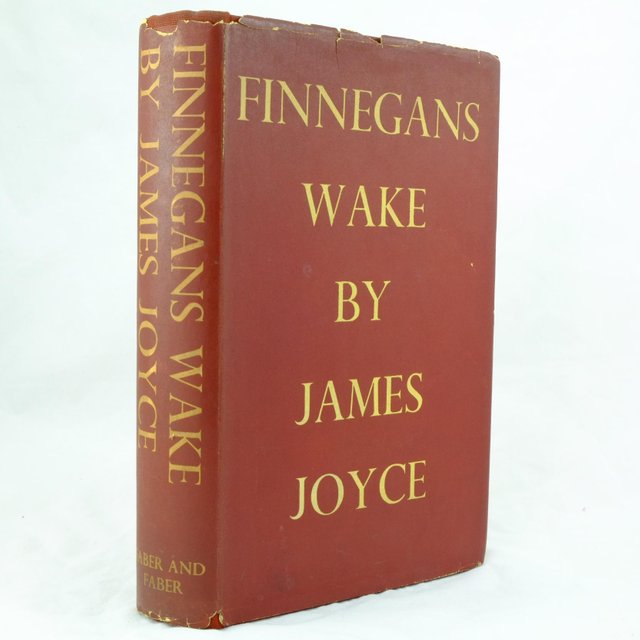
And that’s a good place to stop.
References
- Joseph Bédier, Le Roman de Tristan et Iseut, H Piazza et Compagnie, Paris (1902)
- Luca Crispi & Sam Slote (editors), How Joyce Wrote Finnegans Wake: A Chapter-by-Chapter Genetic Guide, The University of Wisconsin Press, Madison, WI (2007)
- Richard Ellmann, James Joyce, Second Edition, Oxford University Press, Oxford (1982)
- David Hayman, A First-Draft Version of Finnegans Wake, University of Texas Press, Austin TX (1963)
- Robbert-Jan Henkes, 2 Weeks in the Life of James Joyce, Genetic Joyce Studies, Issue 14, Antwerp (Spring 2014)
- Eugene Jolas & Elliot Paul (editors), transition, Number 2, May 1927, Shakespeare & Co, Paris (1927)
- James Joyce et al, The Letters of James Joyce, Volume I, Stuart Gilbert (editor), Volumes II and III, Richard Ellmann (editor), Viking Press, New York (1957, 1966)
- James Joyce, Finnegans Wake, The Viking Press, New York (1958, 1966)
- James Joyce, James Joyce: The Complete Works, Pynch (editor), Online (2013)
- Robert McAlmon (editor), Contact Collection of Contemporary Writers, pp 133-136, Contact Editions, Paris (1925)
- Danis Rose, The Textual Diaries of James Joyce, The Lilliput Press, Dublin (1995)
- Danis Rose, John O’Hanlon, The Restored Finnegans Wake, Penguin Classics, London (2012)
- Florence Simmonds (translator), The Romance of Tristram and Iseult, Translated from the French of Joseph Bédier, William Heinemann, London (1910)
- Peter Timmerman, The First Guide to Finnegans Wake, A Wake Newslitter, New Series, Volume 16, Number 3, June 1979, pp 45-48, Electronic Edition, A Wake Newslitter Press, Scotland (1999)
Image Credits
- Humphriad: © 2010 Stephen Crowe, Adapted, Fair Use
- Two Vignettes: © British Library, BL Add MS 47480 267, 267b, in David Hayman, A First-Draft Version of Finnegans Wake, pp 206-207, University of Texas Press, Austin, TX (1963), Fair Use
- La Place de Rennes, Paris: Public Domain
- Alexandra House, Bognor: © 2020 Google, Fair Use
- Sidlesham Church: © Peter Chrisp, Fair Use
- Tristan and Isolde: Rogelio de Egusquiza (artist), Bilbao Fine arts Museum, Public Domain
- transition 2: Bibliothèque Nationale de France, Département Littérature et Art, 8-Z-24065, Public Domain
- Finnegans Wake (1939): © 2020 Rare and Antique Books, Fair Use
Useful Resources
- Joyce Tools
- FWEET
- The James Joyce Scholars’ Collection
- FinnegansWiki
- James Joyce Digital Archive
- Annotated Finnegans Wake (with Wakepedia)
- From Swerve of Shore to Bend of Bay
- John Gordon’s Finnegans Wake Blog
- James Joyce: Online Notes

🚨🚨🚨Airdrop Alert 🚨🚨🚨
UHIVE Metaverse Adoption Airdrop
GET 100 STEEM and 30000 HVE2 Token Airdrop
On 20th June Uhive Started Their Official partnership with Hive and Steemit community.
For mass adoption towards metaverse they announced their Community Airdrop.
All the members from Hive and Steemit are Eligible for this airdrop.
Airdrop breakdown
This airdrop whitelist will be closed in 72hrs
CLICK HERE TO JOIN AIRDROP WHITELIST NOW